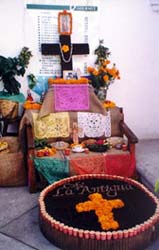 In all of Mexico, The Day of the Dead (and All Saints Day) was once a very important religious holiday. Over the years this holiday has been replaced by more commercial rituals such as those practiced on "Halloween" in the US. However traditional observances of Day of the Dead are still respected in Southern Mexico, where indigenous customs and traditions are still very much alive.
In all of Mexico, The Day of the Dead (and All Saints Day) was once a very important religious holiday. Over the years this holiday has been replaced by more commercial rituals such as those practiced on "Halloween" in the US. However traditional observances of Day of the Dead are still respected in Southern Mexico, where indigenous customs and traditions are still very much alive.
The traditions and myths concerning the dead vary from region to region, however the belief underlying all ceremonies is that the dead (or their spirits) return to earth on this day to be with their families and loved ones.
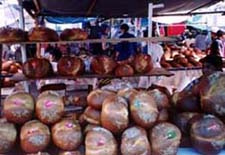 In Oaxaca City, the mixing of Pre-Hispanic and Catholic cultural and religious traditions make for a colorful and magical occasion. Local markets burst with prepatory activities, bakers light the midnight oil to prepare loaves of the special "pan de muertos" (bread of the dead), and playful skeleton imagery dominates storefronts and artisan themes.
In Oaxaca City, the mixing of Pre-Hispanic and Catholic cultural and religious traditions make for a colorful and magical occasion. Local markets burst with prepatory activities, bakers light the midnight oil to prepare loaves of the special "pan de muertos" (bread of the dead), and playful skeleton imagery dominates storefronts and artisan themes.
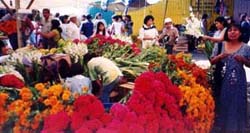 The festival formally begins on October 31st, many families pay honor to their ancestors or deceased loved-ones with the careful and sometimes elaborate construction of an in-house altar. The offerings consist of flowers, food and drinks, candles, photos of the deceased, and incense such as copal. While the occasion is at times solemn, it is also tinged with joyful anticipation and even humor.
The festival formally begins on October 31st, many families pay honor to their ancestors or deceased loved-ones with the careful and sometimes elaborate construction of an in-house altar. The offerings consist of flowers, food and drinks, candles, photos of the deceased, and incense such as copal. While the occasion is at times solemn, it is also tinged with joyful anticipation and even humor.
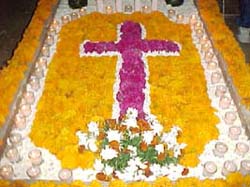 The festivities on the 31st also extend to the cemeteries, where the experience takes on the emotional charge and splendor of a universal tradition: The Cult of the Dead. A pilgrimage is made to the loved-ones' gravesides, carrying flowers and candles as adornments. What begins as a prayerful or meditative religious occasion quickly transforms into a fiesta, complete with musicians and dancing, paper-maché puppets or "gigantes," and fireworks, sometimes lasting through the night and into the first and second days of November.
The festivities on the 31st also extend to the cemeteries, where the experience takes on the emotional charge and splendor of a universal tradition: The Cult of the Dead. A pilgrimage is made to the loved-ones' gravesides, carrying flowers and candles as adornments. What begins as a prayerful or meditative religious occasion quickly transforms into a fiesta, complete with musicians and dancing, paper-maché puppets or "gigantes," and fireworks, sometimes lasting through the night and into the first and second days of November.
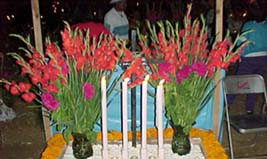 The offerings for the in-house altars or shrines are particular to this occasion and are bought and prepared days before the celebration. Mole (a rich sauce, usually served over chicken, consisting of chocolate, tomatoes, and an impressive assortment of spices), candied pumpkins, pan de muertos, curious candied skulls made of sugar, tamales, and seasonal fruits, are all set upon a special table covered with a white tablecloth.
The offerings for the in-house altars or shrines are particular to this occasion and are bought and prepared days before the celebration. Mole (a rich sauce, usually served over chicken, consisting of chocolate, tomatoes, and an impressive assortment of spices), candied pumpkins, pan de muertos, curious candied skulls made of sugar, tamales, and seasonal fruits, are all set upon a special table covered with a white tablecloth.
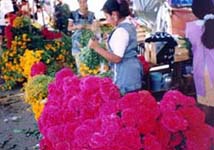 Additionally, cigarettes, mezcal, chocolate or other items that were formally tempting or pleasing to the deceased are displayed. The special marigold-like flowers, "Cemposuchil," seasonal in November, are interwoven with palm leaves that form a colorful and rustic arch over the altar. Paper-cut banners of Day of the Dead imagery are also common.
Additionally, cigarettes, mezcal, chocolate or other items that were formally tempting or pleasing to the deceased are displayed. The special marigold-like flowers, "Cemposuchil," seasonal in November, are interwoven with palm leaves that form a colorful and rustic arch over the altar. Paper-cut banners of Day of the Dead imagery are also common.
Over the years, esthetically the altars have evolved into objects of art, making this celebration a true exposition. Businesses and tourist enterprises also exhibit altars. A number of free events of interest to travelers take place throughout the week in Oaxaca. Consult local tourist boards for complete information.
Written by: Sue Creamer, e-mail: laquesab@oax1.telmex.net.mx
Photos by: Rene Cabrera, e-mail: rene@mexonline.com
|